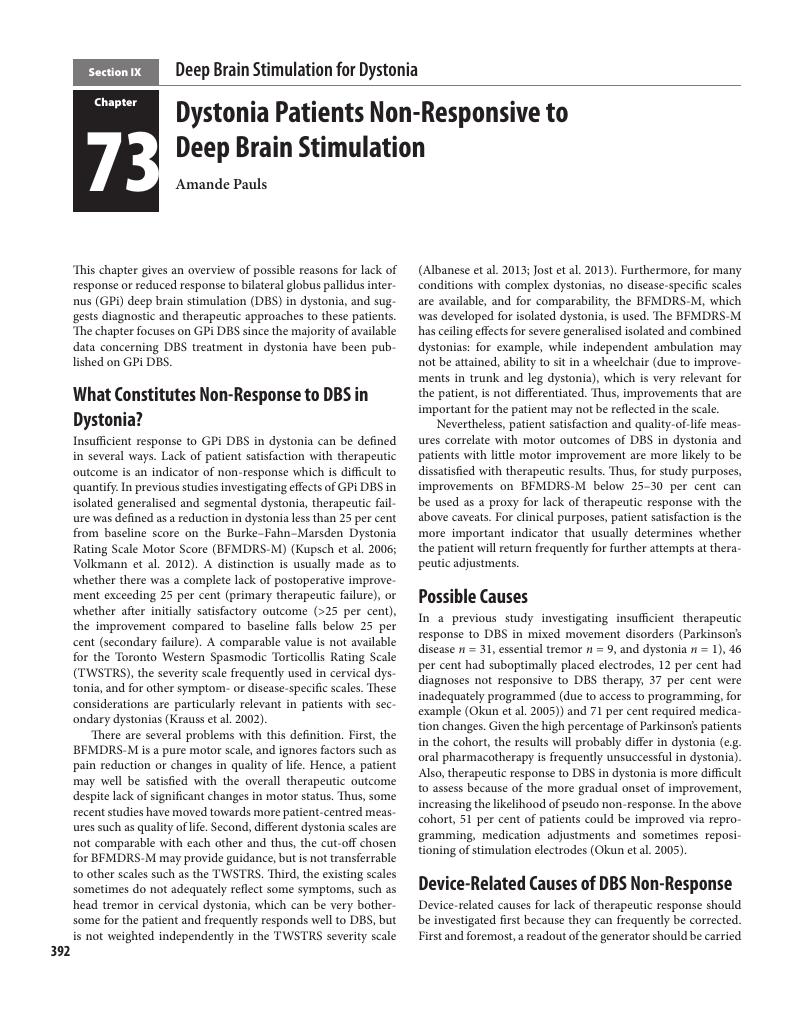Book contents
- Treatment of Dystonia
- Treatment of Dystonia
- Copyright page
- Contents
- Contributors
- Preface
- 1 Development of the Concept of Dystonia as a Disease, a Syndrome and a Movement Phenomenology
- Section I Basics
- Section II Botulinum Toxin Therapy
- Section III Musician’s Dystonia
- Section IV Psychogenic Dystonia
- Section V Treatment of Paediatric Dystonia
- Section VI Rehabilitation of Dystonia
- Section VII Pharmacotherapy for Dystonia
- Section VIII Surgical Treatment of Dystonia
- Section IX Deep Brain Stimulation for Dystonia
- 62 Functional Mechanisms of Deep Brain Stimulation in Dystonia
- 63 Deep Brain Stimulation for Isolated Generalised Dystonia
- 64 Deep Brain Stimulation for Isolated Focal and Segmental Dystonia
- 65 Deep Brain Stimulation for Meige Syndrome
- 66 Contemporary Thalamotomy for Dystonia
- 67 Deep Brain Stimulation for Myoclonus-Dystonia
- 68 Deep Brain Stimulation for Tardive Dystonia
- 69 Deep Brain Stimulation for Choreoathetosis in Cerebral Palsy
- 70 Deep Brain Stimulation for Other Secondary Dystonias
- 71 The Subthalamic Nucleus as a Deep Brain Stimulation Target for Dystonia
- 72 The Thalamus as a Target for Deep Brain Stimulation in Dystonia
- 73 Dystonia Patients Non-Responsive to Deep Brain Stimulation
- 74 Akinesia Induced by Deep Brain Stimulation
- 75 Programing Deep Brain Stimulation for Treatment of Dystonia
- 76 Complications of Deep Brain Stimulation for Dystonia
- Section X Emerging Therapies for Dystonia
- Section XI Future Trends in Dystonia Therapy
- Book part
- Index
- References
73 - Dystonia Patients Non-Responsive to Deep Brain Stimulation
from Section IX - Deep Brain Stimulation for Dystonia
Published online by Cambridge University Press: 31 May 2018
- Treatment of Dystonia
- Treatment of Dystonia
- Copyright page
- Contents
- Contributors
- Preface
- 1 Development of the Concept of Dystonia as a Disease, a Syndrome and a Movement Phenomenology
- Section I Basics
- Section II Botulinum Toxin Therapy
- Section III Musician’s Dystonia
- Section IV Psychogenic Dystonia
- Section V Treatment of Paediatric Dystonia
- Section VI Rehabilitation of Dystonia
- Section VII Pharmacotherapy for Dystonia
- Section VIII Surgical Treatment of Dystonia
- Section IX Deep Brain Stimulation for Dystonia
- 62 Functional Mechanisms of Deep Brain Stimulation in Dystonia
- 63 Deep Brain Stimulation for Isolated Generalised Dystonia
- 64 Deep Brain Stimulation for Isolated Focal and Segmental Dystonia
- 65 Deep Brain Stimulation for Meige Syndrome
- 66 Contemporary Thalamotomy for Dystonia
- 67 Deep Brain Stimulation for Myoclonus-Dystonia
- 68 Deep Brain Stimulation for Tardive Dystonia
- 69 Deep Brain Stimulation for Choreoathetosis in Cerebral Palsy
- 70 Deep Brain Stimulation for Other Secondary Dystonias
- 71 The Subthalamic Nucleus as a Deep Brain Stimulation Target for Dystonia
- 72 The Thalamus as a Target for Deep Brain Stimulation in Dystonia
- 73 Dystonia Patients Non-Responsive to Deep Brain Stimulation
- 74 Akinesia Induced by Deep Brain Stimulation
- 75 Programing Deep Brain Stimulation for Treatment of Dystonia
- 76 Complications of Deep Brain Stimulation for Dystonia
- Section X Emerging Therapies for Dystonia
- Section XI Future Trends in Dystonia Therapy
- Book part
- Index
- References
Summary

- Type
- Chapter
- Information
- Treatment of Dystonia , pp. 392 - 396Publisher: Cambridge University PressPrint publication year: 2018

